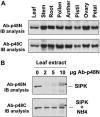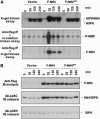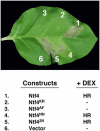Activation of Ntf4, a tobacco mitogen-activated protein kinase, during plant defense response and its involvement in hypersensitive response-like cell death
- PMID: 16798947
- PMCID: PMC1533962
- DOI: 10.1104/pp.106.080697
Activation of Ntf4, a tobacco mitogen-activated protein kinase, during plant defense response and its involvement in hypersensitive response-like cell death
Abstract
Mitogen-activated protein kinase (MAPK) cascades are important signaling modules in eukaryotic cells. They function downstream of sensors/receptors and regulate cellular responses to external and endogenous stimuli. Recent studies demonstrated that SIPK and WIPK, two tobacco (Nicotiana spp.) MAPKs, are involved in signaling plant defense responses to various pathogens. Ntf4, another tobacco MAPK that shares 93.6% and 72.3% identity with SIPK and WIPK, respectively, was reported to be developmentally regulated and function in pollen germination. We found that Ntf4 is also expressed in leaves and suspension-cultured cells. Genomic analysis excluded the possibility that Ntf4 and SIPK are orthologs from the two parental lines of the amphidiploid common tobacco. In vitro and in vivo phosphorylation and activation assays revealed that Ntf4 shares the same upstream MAPK kinase, NtMEK2, with SIPK and WIPK. Similar to SIPK and WIPK, Ntf4 is also stress responsive and can be activated by cryptogein, a proteinaceous elicitin from oomycetic pathogen Phytophthora cryptogea. Tobacco recognition of cryptogein induces rapid hypersensitive response (HR) cell death in tobacco. Transgenic Ntf4 plants with elevated levels of Ntf4 protein showed accelerated HR cell death when treated with cryptogein. In addition, conditional overexpression of Ntf4, which results in high cellular Ntf4 activity, is sufficient to induce HR-like cell death. Based on these results, we concluded that Ntf4 is multifunctional. In addition to its role in pollen germination, Ntf4 is also a component downstream of NtMEK2 in the MAPK cascade that regulates pathogen-induced HR cell death in tobacco.
Figures









Similar articles
-
Chloroplast-generated reactive oxygen species are involved in hypersensitive response-like cell death mediated by a mitogen-activated protein kinase cascade.Plant J. 2007 Sep;51(6):941-54. doi: 10.1111/j.1365-313X.2007.03191.x. Epub 2007 Jul 25. Plant J. 2007. PMID: 17651371
-
Function of a mitogen-activated protein kinase pathway in N gene-mediated resistance in tobacco.Plant J. 2003 Feb;33(4):719-31. doi: 10.1046/j.1365-313x.2003.01664.x. Plant J. 2003. PMID: 12609044
-
Interaction between two mitogen-activated protein kinases during tobacco defense signaling.Plant J. 2003 Apr;34(2):149-60. doi: 10.1046/j.1365-313x.2003.01709.x. Plant J. 2003. PMID: 12694591
-
Pathogen-induced MAP kinases in tobacco.Results Probl Cell Differ. 2000;27:65-84. doi: 10.1007/978-3-540-49166-8_6. Results Probl Cell Differ. 2000. PMID: 10533199 Review.
-
Mitogen-activated protein kinase cascades in signaling plant growth and development.Trends Plant Sci. 2015 Jan;20(1):56-64. doi: 10.1016/j.tplants.2014.10.001. Epub 2014 Oct 22. Trends Plant Sci. 2015. PMID: 25457109 Review.
Cited by
-
Mitogen-activated protein kinase OsMPK6 negatively regulates rice disease resistance to bacterial pathogens.Planta. 2007 Sep;226(4):953-60. doi: 10.1007/s00425-007-0541-z. Epub 2007 May 31. Planta. 2007. PMID: 17541629
-
Deciphering hydrogen peroxide-induced signalling towards stress tolerance in plants.3 Biotech. 2019 Nov;9(11):395. doi: 10.1007/s13205-019-1924-0. Epub 2019 Oct 11. 3 Biotech. 2019. PMID: 31656733 Free PMC article. Review.
-
Protein Kinase Signaling Pathways in Plant-Colletotrichum Interaction.Front Plant Sci. 2022 Jan 20;12:829645. doi: 10.3389/fpls.2021.829645. eCollection 2021. Front Plant Sci. 2022. PMID: 35126439 Free PMC article. Review.
-
Regulation of MAPK signaling and cell death by MAPK phosphatase MKP2.Plant Signal Behav. 2010 Nov;5(11):1497-500. doi: 10.4161/psb.5.11.13645. Epub 2010 Nov 1. Plant Signal Behav. 2010. PMID: 21057191 Free PMC article.
-
GhMPK17, a cotton mitogen-activated protein kinase, is involved in plant response to high salinity and osmotic stresses and ABA signaling.PLoS One. 2014 Apr 17;9(4):e95642. doi: 10.1371/journal.pone.0095642. eCollection 2014. PLoS One. 2014. PMID: 24743296 Free PMC article.
References
-
- Aoyama T, Chua N-H (1997) A glucocorticoid-mediated mediated transcriptional induction system in transgenic plants. Plant J 11: 605–612 - PubMed
-
- Asai T, Tena G, Plotnikova J, Willmann MR, Chiu W-L, Gomez-Gomez L, Boller T, Ausubel FM, Sheen J (2002) MAP kinase signalling cascade in Arabidopsis innate immunity. Nature 415: 977–983 - PubMed
-
- Ausubel FM (2005) Are innate immune signaling pathways in plants and animals conserved? Nat Immunol 6: 973–979 - PubMed
-
- Baker B, Zambryski P, Staskawicz B, Dinesh-Kumar SP (1997) Signaling in plant-microbe interactions. Science 276: 726–733 - PubMed
-
- Boller T (2005) Peptide signalling in plant development and self/non-self perception. Curr Opin Cell Biol 17: 116–122 - PubMed
Publication types
MeSH terms
Substances
Associated data
- Actions
- Actions
LinkOut - more resources
Full Text Sources
Miscellaneous

